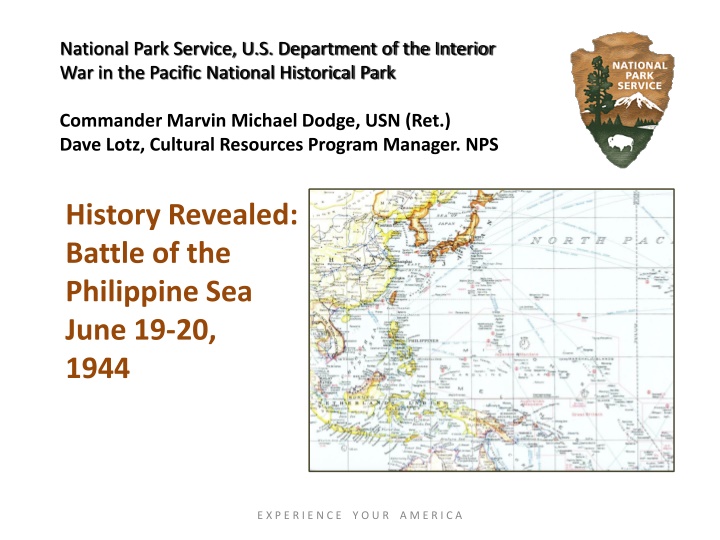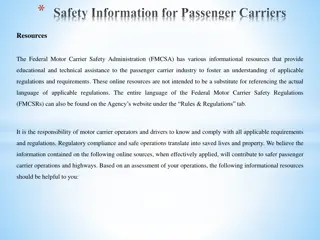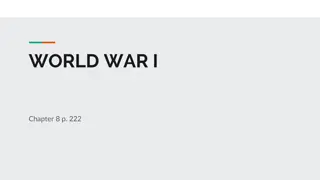Battle of the Philippine Sea: World War II Aircraft Carriers Showdown
Explore the pivotal Battle of the Philippine Sea in 1944, featuring a fierce confrontation between the Imperial Japanese Navy and the United States Navy. Witness the strategic maneuvers of Vice Admiral Jisaburo Ozawa and Admiral Ray Spruance as their fleets clashed with numerous aircraft carriers, battleships, cruisers, and destroyers. Learn about the intense aerial combat involving carrier fighters, dive bombers, and torpedo bombers from both sides in this historic naval engagement.
Download Presentation

Please find below an Image/Link to download the presentation.
The content on the website is provided AS IS for your information and personal use only. It may not be sold, licensed, or shared on other websites without obtaining consent from the author.If you encounter any issues during the download, it is possible that the publisher has removed the file from their server.
You are allowed to download the files provided on this website for personal or commercial use, subject to the condition that they are used lawfully. All files are the property of their respective owners.
The content on the website is provided AS IS for your information and personal use only. It may not be sold, licensed, or shared on other websites without obtaining consent from the author.
E N D
Presentation Transcript
National Park Service, U.S. Department of the Interior War in the Pacific National Historical Park Commander Marvin Michael Dodge, USN (Ret.) Dave Lotz, Cultural Resources Program Manager. NPS History Revealed: Battle of the Philippine Sea June 19-20, 1944 E X P E R I E N C E Y O U R A M E R I C A
Imperial Japanese Navy Vice Admiral Jisaburo Ozawa Commander, Mobile Fleet Admiral Soemu Toyoda CinC, Combined Fleet
United States Navy Admiral Ray Spruance Commander, Fifth Fleet Vice Admiral Marc Mitscher Commander Task Force 58
Fifth aircraft carrier battle of the war Imperial Japanese Navy: 9 aircraft carriers U.S. Navy: 15 aircraft carriers
Accompanying warships 5 battleships 11 cruisers 27 destroyers 7 battleships 18 cruisers 67 destroyers
Carrier Fighters Grumman F6F-3 Hellcat Mitsubishi A6M5 Zero-Sen (Zeke) Crew: One Speed: 346 mph max Range: 1,118 miles Weapons: three 13.2 mm machine guns and two 20 mm machine guns Number: 225 Crew: One Speed: 380 mph max Range: 1,530 miles Weapons: six 0.50 in machine guns Number: 466
Carrier Dive Bombers Yokosuka D4Y1 Suisei (Judy) Curtiss SB2C-1C Helldiver Crew: Two Speed: 342 mph Range: 910 miles Weapons: 1,235 lbs. of bombs two 7.7 mm machine guns one 7.92 mm machine gun Number: 108 Crew: Two Speed: 295 mph max Range: 1,165 miles Weapons: 2,000 lbs. of bombs two 20 mm cannons Number: 154
Older Carrier Dive Bombers Aichi D3A2 (Val) Douglas SBD-5 Dauntless Crew: Two Speed: 239 mph max Range: 913 miles Weapons: 816 lbs. of bombs three 7.7 mm machine guns Number: 27 Crew: Two Speed: 255 mph max Range: 773 miles Weapons: 2,250 lbs. of bombs two 0.50 in machine guns two 0.30 in machine guns Number: 79
Carrier Torpedo Bombers Nakajima B6N1 Tenzan (Jill) Grumman TBM-1C Avengers Crew: Speed: 298 mph max Range: 1,892 miles Weapons: 1,764 lbs. torpedo/bomb two 7.7 mm machine guns Number: 99 Crew: Three Speed: 267 mph max Range: 1,130 miles Weapons: 2,000 lbs. torpedo/bombs two 0.50 in machine guns one 0.30 in machine gun Number: 193
Aircraft numbers Japanese Navy Carrier Fighters Carrier Dive Bombers 135 Carrier Torp. Bombers 99 Land Based Seaplanes TOTAL United States Navy Carrier Fighters Carrier Dive Bombers 233 Carrier Torp. Bombers 193 Land Based Seaplanes TOTAL 225 466 420 0 879 0 17 907
Pilots Japanese American
Fleet Approaches, 0001K 19 June 1944 Japanese Navy steaming east from the Philippines. U.S. Navy positioned to the west of the Mariana Islands to defend the Saipan invasion of June 15, 1944.
Considerations Prevailing Winds from the Northeast. Japanese controlled nearby airfields on Rota, Tinian and Guam. Japanese knew the locations of the American carriers days prior to the battle. The U.S. Navy did not know the locations of the Japanese carriers with the exception of infrequent submarine sightings.
Tactical considerations Admiral Spruance primary purpose was to protect the invasion of Saipan. Admiral Spruance concerned the Japanese might divide forces and execute an end around . Admiral Lee, commander of USN battleships, did not want a night surface engagement.
Submarines Japanese: Had been eliminated around the Mariana Islands American: Deployed to first sight and report the approaching Japanese fleet; Then attack.
Marianas Turkey Shoot June 19: Aerial battle over the U.S. Carriers and over Guam June 20: Chase and attack on the Japanese carriers to the west
Aftermath Japanese losses Aircraft: 550-645 Ships: 3 carriers, 2 oilers Men: 2,987 est. United States losses Aircraft: 123 Ships: none Men: 99 Elimination of Japanese Navy s carrier air power Downfall of the Tojo government in Japan Successful American invasions of Saipan, Guam, and Tinian Continued 1944 westward offensive of the United States in the Pacific with invasions of Peleliu and the Philippines
Key factors for the U.S. victory American pilot training American tactics American technology Advanced American ships and aircraft
It was like an old time turkey shoot down home!
Remnants Off Umatac Bay At Hamanatsu-Minami SDB, Japan
Stateside Remnants USS Hornet, Alameda, CA USS Yorktown, Charleston, SC
Thanks for your interest in our heritage and park!























